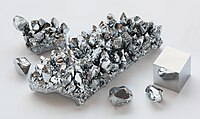
Photo from wikipedia
Abstract In this paper, the stability of low-temperature-gaseous-carburization (LTGC) layer in AISI316L stainless steel was investigated by exposing at temperature between 300 °C to 400 °C from 150 h to… Click to show full abstract
Abstract In this paper, the stability of low-temperature-gaseous-carburization (LTGC) layer in AISI316L stainless steel was investigated by exposing at temperature between 300 °C to 400 °C from 150 h to 3000 h. After carburization, a carburized layer with high carbon content, hardness and huge compressive residual stress forms on the surface of 316L. Because of high carbon atmosphere in the carburizing progress, a soot layer forms on the surface of carburized layer. Tests results show that, carbon atoms in the soot layer will diffuse in the carburized layer continuously in the heat exposure progress. At 300°C, although some carbon atoms diffuse into the alloy and results in carbon content increases in the outmost surface layer, the carburized layer depth doesn't change, surface hardness and surface compressive residual stress decreases only moderately even after heating for 3000 h. When subjected to higher temperature exposure for 3000 h at 350 °C and 400°C, carburized layer thickness increases remarkably while surface compressive residual stress and surface hardness decrease evidently. Although no undesired Cr carbides (such as M23C6) precipitate in the heat exposure process, however, oxidation should be concerned. After heat exposure for 3000 h, the thickness of oxide layer formed at 300 °C is only ∼3 μm, but at 400°C, the thickness of oxide layer increases to ∼13 μm. It can be conclued that the carburized layer is stable below 300°C. Besides, the carbon diffusion in the heat exposure progress was simulated and results show that the diffusion model by considering stress induction and concentration effect is feasible.
Journal Title: Surfaces and Interfaces
Year Published: 2021
Link to full text (if available)
Share on Social Media: Sign Up to like & get
recommendations!